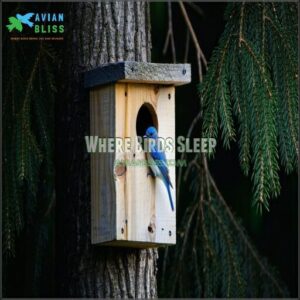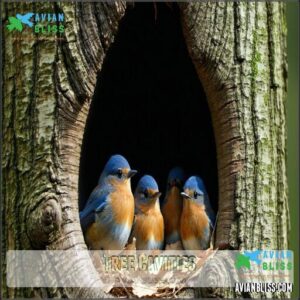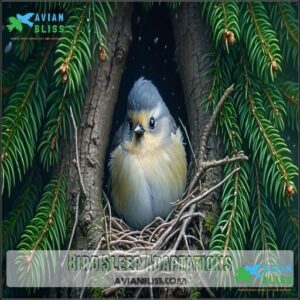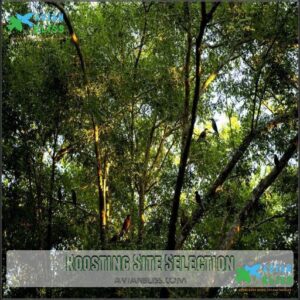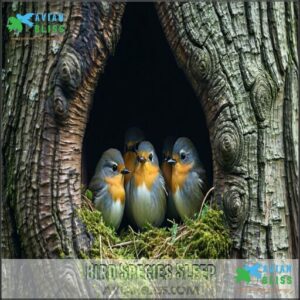This site is supported by our readers. We may earn a commission, at no cost to you, if you purchase through links.

You’ll find many perched on tree branches, using a natural "foot-locking" mechanism to stay secure, while others hide in dense foliage or shrubs for extra cover.
Birds like woodpeckers might choose tree cavities, and some species even seek shelter in man-made structures, like building ledges or barn rafters.
Waterbirds often sleep floating on water, relying on the group for safety, and each species has its own roosting style, perfectly adapted to its environment.
Curious how feathers keep them warm during sleep, and want to learn more about how they stay secure, stick around to learn more!
Table Of Contents
- Key Takeaways
- Birds Sleep Patterns
- Where Birds Sleep
- Roosting Locations
- Sleeping Postures
- Nocturnal Behavior
- Bird Sleep Adaptations
- Roosting Site Selection
- Bird Species Sleep
- Supporting Bird Sleep
- Bird Sleep Conservation
- Frequently Asked Questions (FAQs)
- Do birds sleep at night?
- What is the best sleep position for breathing and brain?
- Where do birds sleep?
- Where do birds sleep in a storm?
- Where do birds roost at night?
- How do nocturnal and diurnal birds sleep?
- Where do birds settle at night?
- How do urban lights impact birds sleep?
- Do weather conditions affect a bird’s sleeping position?
- Can birds sleep while flying during storms?
- Conclusion
Key Takeaways
- Birds sleep in safe spots like tree branches, dense shrubs, tree cavities, or building ledges to avoid predators and bad weather.
- They use adaptations like tucking their beaks into feathers for warmth and a foot-locking mechanism to stay secure while perched.
- Some birds, like migratory species, can sleep mid-flight using unihemispheric slow-wave sleep to rest and stay alert simultaneously.
- Creating bird-friendly habitats with native trees, shrubs, or birdhouses helps provide shelter and supports their nighttime safety.
Birds Sleep Patterns
Birds have unique sleep patterns, often taking brief naps throughout the day and night instead of long rest periods.
They use fascinating adaptations, like unihemispheric slow-wave sleep and a foot-locking mechanism, to stay alert and safe while resting.
Unihemispheric Slow-Wave Sleep
Birds have an amazing trick called unihemispheric slow-wave sleep.
Unihemispheric slow-wave sleep lets birds rest one brain hemisphere while the other stays alert, a brilliant adaptation for predator vigilance.
One brain hemisphere rests while the other stays alert, watching for predators.
This sleep asymmetry helps maintain predator vigilance while flying, roosting, or nesting.
It’s an evolutionary advantage in bird sleep patterns, showing advanced avian cognition.
Such bird sleeping habits are essential for survival, especially in risky nocturnal bird behavior or unfamiliar environments, which relies on predator vigilance.
Foot-Locking Mechanism
You’ve probably noticed birds perched on branches without slipping, even while they sleep.
That’s thanks to a unique tendon structure in their legs, which is an evolutionary advantage that offers perch stability.
This mechanism locks their feet securely without requiring constant muscle engagement, keeping them safe from falls, and it’s a key part of their roosting behavior.
Bird sleep patterns include this fascinating grip strength.
Sleep Duration Variations
While sleep patterns vary widely, bird sleep is influenced by species differences, activity levels, and environmental impact.
Some nap for minutes, while others rest longer.
- Day-active species: Short rest periods, staying alert.
- Nocturnal behavior: Extended nighttime sleep for certain bird species.
- Environmental factors: Cold or predator presence may alter sleep quality.
Age influence adds complexity to bird behavior.
Where Birds Sleep
When it’s time to rest, birds find creative ways to guarantee safety from predators.
Roosting behavior varies by species—some birds sleep in trees, others on ledges or in shrubs.
They often prioritize high places to avoid roosting dangers like ground-based predators.
Urban roosts, such as building ledges, offer similar security.
Materials for roosting include dense foliage and natural cavities.
While many birds sleep outdoors, some use nest boxes for extra protection.
Birds also seek shelter from the elements, and may utilize dense evergreen vegetation for protection from rain.
Overall, bird sleep locations balance altitude, shelter, and safety.
| Sleep Location | Example Birds | Protection Provided | Material/Spot Used |
|---|---|---|---|
| Dense Foliage | Songbirds | Hides from predators | Bushes, thick trees |
| Tree Cavities | Woodpeckers | Shelter from weather | Natural hollows |
| Urban Ledges | Pigeons | Distance from ground threats | Building edges |
| Nest Boxes | Bluebirds | Extra security | Man-made structures |
Roosting Locations
You’ll find birds choosing their roosting spots based on safety and shelter, not comfort.
From tree cavities to dense foliage or even man-made structures, these locations provide the protection they need from predators and harsh weather, ensuring their protection.
Tree Cavities
In terms of safe bird sleep locations, tree cavities are a favorite.
These small spaces, created through natural wear or clever excavation methods, protect against predators and harsh weather.
Species preference matters, with cavity nesting birds like woodpeckers and bluebirds seeking specific sizes.
Many birds, however, are diurnal, active during the day and asleep at night.
Here are bird roosting behavior highlights:
- Warmth retention.
- Predator avoidance.
- Shared body heat.
- Strategic cavity location.
- Reduced cavity competition.
Dense Foliage
When choosing roosting sites, birds often depend on dense foliage for Predator Camouflage and Bird Safety.
Thick vegetation, like leafy trees and shrubs, acts as a shield, hiding them from predators while ensuring Roosting Comfort.
The Habitat Quality of trees directly influences bird roosting behavior, making these safe, natural bird roosting sites indispensable.
Shrubs and Vines
Birds sleep in shrubs and vines because they offer amazing advantages.
Their thorn protection deters predators, while vine density provides the perfect camouflage benefits.
Plus, shrub height guarantees a safe perch away from ground dangers.
Species preference plays a role too—small songbirds and sparrows often love these spots.
- Benefits of Shrubs for Roosting:
- Thorn protection guarantees safety.
- Dense vines aid camouflage.
- High shrubs shield from predators.
Man-Made Structures
Urban bird roosts are essential for bird safety. Birds often snooze on building ledges or under overpass shelters, tucking their heads into feathers.
Birdhouses mimic natural cavities, offering cozy spots to rest. Even power lines become perches for sleep in urban areas.
Consider using specialized roosting boxes to provide shelter. Creating bird-friendly environments helps guarantee safe resting places in bustling cities, promoting both bird safety and harmony in shared spaces.
Sleeping Postures
When birds sleep, their postures are as fascinating as they’re functional.
Bird sleep postures blend function and charm, showcasing evolution’s brilliance in conserving energy and ensuring survival.
Whether standing on one leg, floating on water, or tucking their beaks into feathers, each position helps them conserve energy and stay secure.
Standing on One Leg
Resting on one leg isn’t just charming—it’s science in action! Many bird species, while sleeping or resting, stand on a single leg to conserve heat and reduce leg muscle fatigue.
This balance mechanism reflects evolutionary advantages tied to bird sleep survival.
- Minimizes body heat loss through tucking one leg.
- Reduces strain on muscles during rest.
- Varies across species based on habitat.
Floating on Water
Picture waterbirds snoozing on calm waters, their buoyancy adaptations keeping them afloat.
Ducks, geese, and swans often rely on flock safety, sticking together for warmth and predator avoidance.
These bird species prefer shoreline roosting, balancing rest and alertness.
Sleeping on water provides excellent escape potential, making it a clever survival tactic in their bird habitats, and it’s both peaceful and practical.
Tucking Beak Into Feathers
Ever noticed how birds tuck their beaks into feathers? It’s a clever move for heat conservation.
By positioning their bills snugly, they trap warmth, especially in colder weather. This sleeping comfort varies by species but always aids insulation.
It shows how birds stay warm while they sleep, blending feather warmth with instinctive behavior for survival in chilly conditions.
Nocturnal Behavior
You’ll find that nocturnal birds, like owls and nightjars, are active after sunset, using the quieter night to hunt and forage.
During the day, they rest in hidden spots, conserving energy and avoiding predators while awaiting nightfall.
Diurnal Vs Nocturnal Birds
Birds’ activity timing defines their sleep schedules.
Diurnal birds, like sparrows, rest at night, seeking safety in roosting spots.
Nocturnal birds, such as owls, come alive after dusk using sensory adaptations to hunt or forage.
Urban impact alters behaviors too, with some shifting routines for food or reduced noise.
Sleep varies, balancing conservation needs and predator avoidance in changing environments.
- Diurnal rest at night.
- Nocturnal hunt at night.
- Urban areas shift routines.
- Roosting guarantees safety.
Nighttime Singing
At night, some birds enchant listeners with urban serenades and soothing melodies.
Species variations, like the nightingale and Eastern Whip-poor-will, sing for territorial defense or mate attraction.
Reduced noise in cities amplifies these nighttime behaviors.
While most birds sleep, a few seize the stillness of dusk to communicate, making nighttime bird song a fascinating aspect of their roosting patterns, and showcasing their ability to thrive in urban environments with soothing melodies.
Migration Patterns
During migration, birds rest strategically.
Migratory sleep happens mid-flight or at stopover habitats.
Their navigation style, like using stars, keeps them safe while flying long distances.
Altitude effects impact energy, so they pause in sheltered spots for bird nighttime safety.
Visual landmarks also guide them to safe locations.
These patterns reveal how distance impacts bird sleep, showcasing their incredible adaptability for survival during challenging journeys.
Bird Sleep Adaptations
Birds use unique adaptations, like specialized feathers and torpor, to stay warm and conserve energy while they sleep.
By tucking their legs and even lowering their metabolism, they can rest efficiently in diverse environments, utilizing specialized feathers to achieve this.
Feathers and Insulation
Staying warm is key when birds sleep.
Their feather structure provides incredible insulation mechanisms, keeping heat trapped close to their bodies. Regular preening helps feathers remain in top shape.
Molting impacts this insulation, as old feathers shed for renewed warmth. Species variations mean some fluff up while others rely on denser layers.
These bird sleep facts show nature’s clever design, highlighting the importance of feather structure in maintaining warmth.
Tucking Legs Into Body
Tucking one leg into their body is an ingenious way for birds to stay warm during roosting.
This leg tuck benefits blood circulation and minimizes heat loss, keeping their core cozy.
Species variations exist—some prefer trees, others rest in cavities—but this adaptation highlights bird warmth and feathers’ efficiency.
It’s an evolutionary example of thriving, whether birds sleep trees or snug in hidden spots, showcasing their ability to stay warm.
Torpor and Metabolism
Torpor is a remarkable survival strategy birds use to conserve energy.
By lowering their metabolic rate and body temperature, they reduce energy expenditure during sleep.
Unlike normal rest, torpor involves controlled metabolic suppression, making it essential for cold nights or scarce food.
However, it’s not without risks—long torpor durations can delay arousal mechanisms, leaving birds vulnerable to predators or diseases, which can be a significant threat to their survival during periods of torpor.
Roosting Site Selection
When birds choose a sleeping spot, they look for places that offer shelter from the weather and protection from predators.
Roosting sites near food and water sources also help them conserve energy for survival.
Shelter From Weather
When weather turns rough, birds seek roosting shelters to stay safe and warm.
They’ve adapted clever ways to handle extreme weather through thermal regulation.
Here’s where birds roost for wind protection:
- Dense foliage – Thick leaves block wind and rain.
- Tree cavities – Insulated roosting materials trap heat.
- Man-made structures – Hideaways shield from seasonal changes.
Birds may also use a specialized roosting box for shelter.
Protection From Predators
Birds choose roosting spots that keep them hidden and safe from predators.
Elevated perches, like tree branches, and dense foliage offer strong camouflage roosting, while thorns act as natural "security systems."
Cavity security in trees or structures provides extra protection.
Flock safety also helps, with birds grouping together to enhance predator detection while they sleep peacefully in bird sleep shelters.
Food and Water Proximity
Roosting birds often select spots near water sources and abundant foraging areas to meet their calorie needs.
Feeding habits play a big role in choosing bird sleep shelters, ensuring energy for predator avoidance.
Whether birds sleep in nests, cavities, or foliage, proximity to food reduces roosting energy spent traveling.
This balance helps maintain survival and warmth throughout the night.
Bird Species Sleep
You’ll notice birds have unique sleeping habits, shaped by their species and environment.
From waterbirds resting on lakes to songbirds perched on branches or cavity-nesting birds tucked into tree holes, each adapts to stay safe and warm at night, with unique habits that help them survive.
Waterbirds and Shorebirds
Waterbirds and shorebirds have fascinating aquatic roosting habits. Near coastal habitats, they rely on flock dynamics and migration strategies to rest safely.
To avoid predators while roosting, they sleep uniquely:
- Ducks float, tucking bills into feathers.
- Shorebirds hunker on the ground or submerged logs.
- Some birds nap mid-flight.
- Vigilant predator detection guarantees survival during rest.
Songbirds and Tree Branches
Songbirds seek secure, hidden spots on tree branches for roosting.
They often perch within dense foliage near trunks, benefiting from camouflage for predator protection.
Social roosting offers added safety and warmth during cooler nights.
Their branch selection is strategic, prioritizing perch security and weather protection.
Sleeping high in trees keeps them safe, blending survival instincts with efficient rest.
Their grip is aided by specialized feet.
Cavity-Nesting Birds
For safety and warmth, cavity-nesting birds, like woodpeckers, sleep inside tree cavities or specially designed nest boxes.
These snug spaces block harsh weather and predators.
Proper cavity size and nest box design reduce competition between species.
Woodpecker adaptations, such as strong beaks, also help excavate their roosts.
Conservation efforts for these birds support habitats, ensuring secure roosting spaces throughout the year.
Supporting Bird Sleep
You can support birds’ sleep by providing native trees, shrubs, or protected spaces in your yard.
These natural habitats offer shelter from predators and harsh weather, creating safe and comfortable roosting spots.
Native Trees and Shrubs
If you want to support birds’ sleep, adding native trees and shrubs to your yard is a smart move.
These plants provide natural shelter that mimics roosting spots found in the wild. Dense foliage protects bird species from weather and predators while creating a thriving backyard ecosystem.
Habitat restoration also helps birds sleep better, and it supports nests and other bird-friendly spaces. You can also improve their habitat by providing a water source for drinking and bathing.
Check planting guides to select species that suit your environment, boosting bird conservation from the ground up.
Bird-Friendly Habitats
Creating bird-friendly environments in your backyard can help support roosting birds and promote habitat conservation.
Start by incorporating native plantings, which provide natural bird shelter and protection.
Nest box placement is another key step—select spots that mimic natural cavities for safe roosting.
Consider adding native plants for birds to further enhance their habitat.
Avoid trimming dense foliage, as it offers critical cover during rest.
Backyard birdscaping guarantees birds sleep safely, whether they prefer nests, shrubs, or trees.
By creating these habitats, you’re protecting bird sleep while fostering a vibrant ecosystem.
Bird Sleep Conservation
You play a pivotal role in helping birds get the sleep they need by protecting their habitats.
Preserving safe roosting spots guarantees birds can rest, stay alert for predators, and continue their essential roles in ecosystems.
Essential Ecosystem Roles
When birds sleep and roost, they support habitat health and bird ecosystems through roles like seed dispersal, pest control, and pollination services.
Their natural behaviors during restful periods substantially maintain balance in their ecosystems without you even realizing it.
By roosting in various spots, they enhance bird ecology by spreading seeds or managing pests. Scavenging roles also keep environments clean, which is a crucial aspect of maintaining ecosystems.
Protecting Sleep Habitats
To protect bird sleep habitats, focus on small yet impactful changes.
- Habitat Restoration: Plant native trees and shrubs or install nest boxes to support roosting.
- Predator Control: Maintain safe areas to guarantee bird predator avoidance.
- Light Pollution: Minimize nighttime lighting to reduce roosting disruptions.
- Chemical Exposure: Avoid pesticides near bird nests for healthier, bird-friendly habitats.
Conservation efforts help birds thrive!
Baby Bird Sleep and Safety
Baby birds rely on Nestling Warmth and Parental Protection for safety.
Fledgling Vulnerability increases at night, so they find hidden spots in brush or trees.
Habitat Safety and bird predator avoidance are vital, as predators lurk.
When birds sleep in nests or cavities, parental care continues.
Guarantee bird protection by minimizing threats, keeping pets indoors, and leaving fledglings undisturbed.
Frequently Asked Questions (FAQs)
Do birds sleep at night?
Birds sleep at night, but they don’t fully rest like you might.
Many tuck into trees, bushes, or cavities, staying partially alert to avoid predators.
Some even doze with one eye open for extra safety.
What is the best sleep position for breathing and brain?
Oddly enough, the best sleep position is on your side.
This helps keep your airways open for easier breathing and may improve brain health by aiding glymphatic system function, which clears toxins during sleep.
Where do birds sleep?
At night, birds find hidden, safe spots like tree branches, dense shrubs, or cavities.
They prioritize places protected from predators and weather, using foliage, thorny bushes, or even man-made structures like birdhouses for shelter, which provides them a sense of safety and shelter.
Where do birds sleep in a storm?
When storms roll in, birds seek nature’s safest hideaways—dense tree foliage, shrubs, or hollows in branches.
They hunker down, shielded from wind and rain, conserving warmth with fluffed feathers, while staying alert for predators, utilizing their instinct to find safest hideaways.
Where do birds roost at night?
At night, birds roost in safe spots like dense trees, thorny shrubs, cavities, or sheltered ledges.
These places offer protection from predators and weather, ensuring they stay warm, secure, and ready for a new day, with safe spots being crucial for their survival.
How do nocturnal and diurnal birds sleep?
When darkness falls, diurnal birds tuck into branches or cozy cavities, while nocturnal birds, like owls, snooze during the day in trees or caves.
They adapt their sleeping spots for safety, warmth, and protection.
Where do birds settle at night?
Birds settle in sheltered spots like dense trees, thorny shrubs, and tree cavities for protection.
They prioritize safety, warmth, and concealment from predators when choosing roosts.
Some use building ledges, while waterbirds sleep near water.
How do urban lights impact birds sleep?
City lights confuse birds, disrupting natural sleep cycles.
Bright lights make it harder for them to find dark, safe roosts, causing stress and exhaustion.
Providing dim environments or shielding outdoor lights can help them rest better.
Do weather conditions affect a bird’s sleeping position?
Weather directly influences how birds sleep.
During wind or rain, they might hunker down, face the wind, or fluff feathers for warmth.
On calm nights, they often perch upright, balancing safely on branches, which is a complete concept of how they adapt to different weather conditions.
Can birds sleep while flying during storms?
During storms, some migratory birds can sleep while flying using unihemispheric slow-wave sleep.
This lets half their brain rest while the other stays alert, helping them navigate turbulence and avoid danger mid-flight.
Conclusion
Just as many ancient travelers sought shelter in caves or under the stars, birds have perfected their own nightly routines to thrive in diverse environments.
From tree cavities to floating on water, where birds sleep at night depends on safety, comfort, and survival instincts.
By understanding their unique roosting behaviors and adaptations—like foot-locking and feathers for warmth—you can better appreciate their resourcefulness.
Consider creating a bird-friendly habitat to support these fascinating creatures in their nocturnal rest.
- https://www.mpg.de/12722539/0213-verh-060830-a-deeper-look-inside-the-sleeping-bird-brain
- https://www.birdsandblooms.com/birding/birding-basics/birds-sleep-night/?srsltid=AfmBOorLSvb9-7seoxtT6dM3VHI3XGTHBSkiX7wK7KT-IqjmLsOWO5Fe
- https://chirpforbirds.com/wild-bird-resources/where-do-birds-sleep-at-night/?srsltid=AfmBOoqTEYVp_UOAd2WGq2_-LgA2Zgj0E41D-EaGdgI1_8uWgH1xvrK5
- https://slate.com/technology/2014/01/where-do-birds-sleep-roosting-in-nests-water-flocks-cavities.html
- https://www.reddit.com/r/askscience/comments/21h1kt/where_do_birds_go_at_night/


